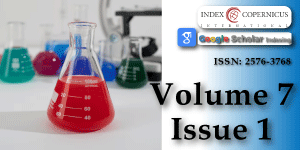Nuclear science and magnetic carbon: a promising way from a chemical method to detect and fight cancer and tumors/neoplasms
Main Article Content
Abstract
In 2005 we reported for the first time on a chemical route aiming to synthesize stable magnetic carbon/graphite. By using the Nuclear Magnetic Resonance (NMR) technique we have verified that its magnetism is an intrinsic property of this synthesized material and not originated from ferromagnetic impurities of any kind. Through direct measurement of the local magnetic field using Carbon-13, we have concluded that its magnetism originated from defects in the structure. From its biocompatibility, we have been working on the use of magnetic carbon/graphite to deliver many compounds aiming to fight different diseases. Despite all the scientific and technological advances of the present day, cancer is a multifactorial and difficult-to-treat disease, killing hundreds of thousands of people a year worldwide. Therefore, the development of a new and efficient drug delivery system to fight cancer – among other diseases - is as important as the discovery of a novel active molecule. In this review of our own work, we show the drug delivery system named MAGUS® (an acronym for Magnetic Graphite Universal System) we have built based on nanostructured magnetic carbon/graphite. This is an innovative and promising system composed of a biocompatible nanostructured particle of magnetic carbon/graphite functionalized with different molecules and materials. MAGUS®, depending on what we link to its structure, is so versatile and can be used to detect a wide range of specimens, from tumors and cancers to chemical and biological agents used as non-conventional weapons. That is why we call it universal. In the present work, MAGUS® will be acting as a biosensor, where the magnetic carbon/graphite is functionalized with radioactive particles of Iodine-131 and antibodies of different types of cancer. Then, by focusing on both the antigen-antibody interaction and the spatial guiding through an external magnetic field we are providing our drug delivery system a double way to detect and reach just the target. Based on these strategies, the functionalized magnetic carbon/graphite will reach only the neoplasm and not the surrounding healthy cells around. In a general view, it means that we are giving specificity to the MAGUS® drug delivery system as a pioneering and effective way to detect and treat cancers. We are also working on this unprecedented and efficient drug delivery system using the principles of Boron Neutron Capture Therapy (BNCT) with Boron-10 instead of Iodine-131. BNCT technique uses neutrons as the external source and is frequently employed to treat specific tumors that are radio resistant or very difficult to kill using conventional radiation therapy. In summary, we show here for the first time that our Magnetic Graphite Universal System associated with nuclear techniques can be successfully used as a biosensor to detect and fight cancers and tumors with powerful features that conventional delivery drug systems and other treatments do not have at all.
Article Details
Copyright (c) 2023 EB Simão-Silva, NFG Serrano, MPC de Medeiros, JF Galdino, FM Araujo-Moreira

This work is licensed under a Creative Commons Attribution 4.0 International License.
Galdino JF. The importance of integrating the military innovation system and the national innovation system; in: Collection of opinion articles on strategic studies in defense and security. ISBN 978-65-87080-44-4; JC Sanches, FM Araujo-Moreira. 2023; 155.
GPT-4 Heralds An Enormous Productivity Boost, And A Wrenching Transformation Of Work (forbes.com) (consulted in March, 2023.
Cancer statistics. 2022 - PubMed (nih.gov) (consulted in March 2023).
Cancer (who.int) (consulted in March 2023).
Mombrú AW, Pardo H, Faccio R, De Lima OF, Leite ER, Zanelatto G, Lanfredi AJC, Cardoso CA, Araújo-Moreira FM. Multilevel ferromagnetic behavior of room- temperature bulk magnetic graphite; Phys. Rev. B (Rapid Comm.). 2005; 71:100404(R).
Pardo H, Faccio R, Araújo-Moreira FM, De Lima OF, Mombrú AW. Synthesis and characterization of stable room temperature bulk ferromagnetic graphite; Carbon. 2006; 44:565–569.
Souza NS, Sergeenkov S, Speglich C, Rivera VAG, Cardoso CA, Pardo H, Mombrú AW, Rodrigues AD, De Lima OF, Araújo-Moreira FM. Synthesis, characterization, and magnetic properties of room-temperature nanofluid ferromagnetic graphite; Appl. Phys. Lett. 2009; 95:23; 233120.
Freitas JC, Scopel WL, Paz WS, Bernardes LV, Cunha-Filho FE, Speglich C, Araújo-Moreira FM, Pelc D, Cvitanić T, Požek M. Determination of the hyperfine magnetic field in magnetic carbon-based materials: DFT calculations and NMR experiments. Sci Rep. 2015 Oct 5;5:14761. doi: 10.1038/srep14761. PMID: 26434597; PMCID: PMC4593005.
Ribeiro LN, Alcântara AC, Darder M, Aranda P, Herrmann PS Jr, Araújo-Moreira FM, García-Hernández M, Ruiz-Hitzky E. Bionanocomposites containing magnetic graphite as potential systems for drug delivery. Int J Pharm. 2014 Dec 30;477(1-2):553-63. doi: 10.1016/j.ijpharm.2014.10.033. Epub 2014 Oct 16. PMID: 25455784.
Souza NS, Sergeenkov S, Rodrigues AD, Cardoso CA, Pardo H, Faccio R, Mombrú AW, Galzerani JC, De Lima OF, Araujo-Moreira FM. Stability issues and structure-sensitive magnetic properties of nanofluid ferromagnetic graphite; J. of Nanofluids. 2012; 1:143–147.
Souza NS, Rodrigues AD, Cardoso CA, Pardo H, Faccio R, Mombru, Galzerani JC, De Lima OF, Sergeenkov S, Araujo-Moreira FM. Physical properties of nanofluid suspension of ferromagnetic graphite with high Zeta potential; Phys. Lett. A. 2012; 376:4; 544-546.
Araujo-Moreira FM, Serrano NFG. Stable Room-Temperature Magnetic Carbon Graphite: From Discovery to Bionanotechnological Applications; Research and Development in Material Science. 2022; 17: 2.
Abbas K, Simonelli F, Holzwarth U, Gibson P. Overview on the production of radioactive nanoparticles for bioscience applications at the JRC Cyclotron – European Commission; Journal of Labelled Compounds and Radiopharmaceuticals. 2009; 52: S231–S255.
Malouff TD, Seneviratne DS, Ebner DK, Stross WC, Waddle MR, Trifiletti DM, Krishnan S. Boron Neutron Capture Therapy: A Review of Clinical Applications. Front Oncol. 2021 Feb 26;11:601820. doi: 10.3389/fonc.2021.601820. PMID: 33718149; PMCID: PMC7952987.
Kiseleva V, Gordon K, Vishnyakova P, Gantsova E, Elchaninov A, Fatkhudinov T. Particle Therapy: Clinical Applications and Biological Effects. Life (Basel). 2022 Dec 9;12(12):2071. doi: 10.3390/life12122071. PMID: 36556436; PMCID: PMC9785772.
Matsumoto Y, Fukumitsu N, Ishikawa H, Nakai K, Sakurai H. A Critical Review of Radiation Therapy: From Particle Beam Therapy (Proton, Carbon, and BNCT) to Beyond. J Pers Med. 2021 Aug 23;11(8):825. doi: 10.3390/jpm11080825. PMID: 34442469; PMCID: PMC8399040.

